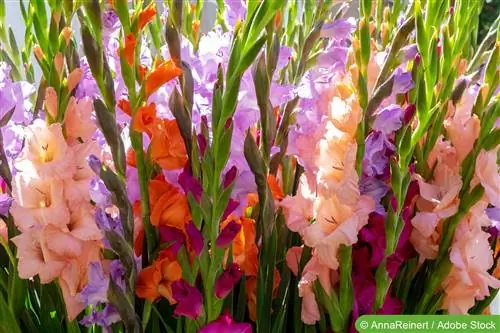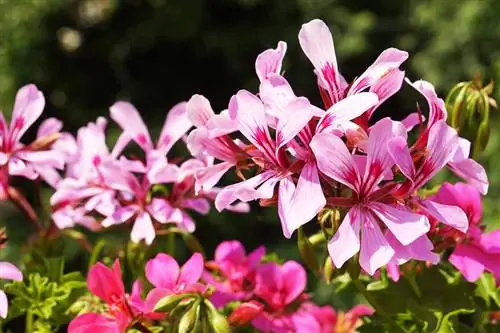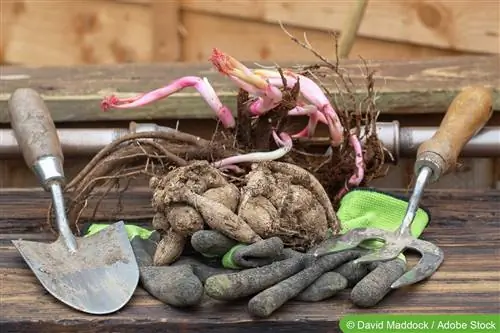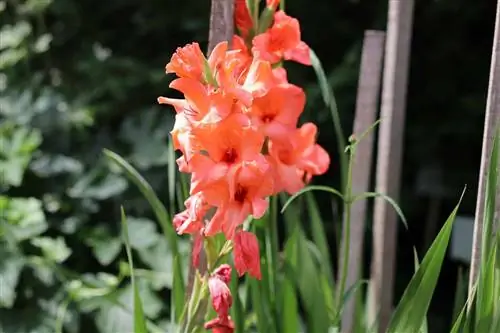- Author admin [email protected].
- Public 2023-12-17 03:39.
- Last modified 2025-01-24 12:45.
Gladiolus belong to the iris family and are originally native to South Africa. The plant is enjoying ever-growing popularity as a classic cut flower. With their long flower stalks, they are often used as a decorative element in large vases. But the colorful ornamental plant also looks great in the garden. The gladiolus is an easy plant to grow and is ideal for the hobby garden.
When is the best time to plant the gladioli?
The optimal time for sowing depends heavily on the gladiolus variety. The large-flowered garden varieties should be planted in April. However, wild forms should be sown in late autumn (October, November). But before the first night frost. The plant prefers a sunny location. Important: Plant the tubers in a different location than last year to ensure full bloom. For wild gladioli, the tubers are planted approximately 8 to 10 centimeters into the ground. When planting in groups, a minimum distance of 12 to 14 centimeters should be maintained. For garden gladioli, the planting depth is 12 to centimeters and they should be planted at a minimum distance of 16 centimeters. To prevent diseases, the tubers can be soaked in an insecticide solution for a few hours before planting.
So that the gladioli survive the winter he althy, the tubers of large-flowered garden varieties must be dug up after the first frost. Cut the stems back to approx. 5 cm. Then check for pests and rot and remove affected areas. The tubers can then be stored frost-free and dry at a maximum of ten degrees. A garage or the basement are suitable storage locations. The tubers of the wild forms can remain in the ground all year round.
- Location: sunny
- Sowing wild forms: October, November
- Sowing garden varieties: April
It's all about the right soil
All gladioli prefer nutrient-rich and water-permeable soil. Heavy clay soils should therefore be loosened up with sand, mulch or compost.
If the soil is acidic, you can add around 60 to 120 grams of dolomite or lime per square meter. Rotted cattle manure, complete fertilizer or rose fertilizer are suitable for enriching the soil with additional minerals. If the soil is heavy, using a plant fleece can also be an advantage. This fleece is available in many garden centers. Before planting, slits are cut in the flow and the tuber is then wrapped in it.
How big do the gladioli get and when does the flowering period begin?
The large-flowered garden varieties reach a height of 100 to 125 centimeters. The wild forms, on the other hand, are somewhat smaller and only grow to 60 to 80 centimeters. The flowering time depends heavily on the variety. Most garden varieties bloom from June to September. The wild varieties begin to bloom in July and, depending on the variety and the weather, can bloom until October.
Both garden gladioli and wild gladioli come in a wide variety of colors and create a true colorful spectacle in the garden during the flowering months.
A selection of colors:
- white (G. Amsterdam)
- yellow (G. Nova Lux)
- salmon (G. Peter Pears)
- yellow in the middle and pink on the outside (G. Windsong)
- pupurrosa (G. communis
What you need to consider when caring for gladioli
As soon as the first stems of the plants can be seen, a net with coarse mesh should be stretched over the bed. The net can be stretched at a height of 25 to 30 centimeters for garden varieties. For wild varieties, 15 to 20 centimeters are sufficient.
The net ensures straight growing stems and also serves as leaf spears. In addition, it supports the plant, the gladioli lose less strength and therefore produce perfect flowers. Under no circumstances should you do without a net, especially for garden gladioli.
In summer, the plants need to be watered sufficiently, but they should not be drowned. It is best to water the plants twice a day, in the early morning and in the evening.
Which fertilizer should be used
Fertilizers that are mixed into the irrigation water are best suited. It is important that the gladioli are supplied with sufficient nutrients, especially at the beginning of the flowering period. In addition to commercially available mineral fertilizers, bark mulch and special flower fertilizers are suitable. Under no circumstances should you use fresh humus or manure, as these can contain fungi, bacteria and other pathogens. The occasional addition of lime and horn shavings further promotes the growth of the plant. Fertilizing should be stopped no later than 4 weeks after the plants have started to flower. In this way, the excess nutrients are flushed out of the tuber and it is ready for overwintering.
- Water-soluble mineral fertilizer
- Bark mulch
- Horn shavings
- Lime
Help with pests and diseases
The most common pests are snails, caterpillars and aphids. These do not have to be sold with pesticides. Snails and caterpillars can be removed by hand. It is advisable to use gardening gloves, especially when dealing with caterpillars. In order to avoid rot on the plants, it is essential to choose a very sunny location. Gladioli do not feel comfortable in the shade. Fungal infestation can only be stopped with generous pruning of the affected areas. In rare cases, chemical pesticides can also provide relief.
Gladiolus as cut flowers
Gladiolus are very suitable as cut flowers. Plant pruning should be carried out in the morning if possible. For optimal plant growth, first select the plants that do not have a second flower in the process of blooming. To enjoy a second flowering of the gladiolus, it is advisable to leave many leaves on the plant, which promote rapid regeneration. For longer-term flowering, the plant should be placed in lukewarm water after cutting. Gladioli keep particularly well in tall vases. With their robust stems, gladioli are ideal for flower arrangements. With gladioli, it is important that no other plants are placed in the vase.
Flower cutting
- Divorce in the morning
- Leave lots of leaves for quick regeneration
- Only cut plants that do not fully bloom
- Lukewarm water and tall vases promote a long shelf life
- Renew the water daily
Wintering
Before overwintering, do not cut the plants too much so that strength can be collected. First, leave as much foliage as possible on the plant. Remove the tubers from the ground in late autumn and remove leaves. Allow to dry in an airy place and store in a dark and dry place at low temperatures. In winter, it is important to rotate the tubers regularly to prevent rot.
Interesting facts about gladioli
Gladiolus are native to Africa, southern Europe and the Middle East. Very colorful species grow in South Africa. In Germany, gladioli are primarily used as ornamental plants. But there are also significant stocks of wild gladioli in Germany.
Gladiolus love moderately nutritious, loose and slightly moist soil. If there is drought, they must be watered sufficiently. Gladiolus in a vase also needs a lot of water. If you want to bring a cut flower to full bloom, you should remove the top bud. Thanks to this measure, the inflorescences do not droop and last longer.
The gladiolus tubers can be removed from the ground in October when the leaves have yellowed. The leaves are cut off close to the tuber. The tubers should be stored in a room that is frost-free and dry. The dry skin of the tubers is removed and the so-called brood tubers are carefully detached. This way the tubers can overwinter.
From mid-April to the beginning of June you can plant the tubers again, preferably about 15 cm apart from each other. To prevent thrips, place the gladiolus tubers in an insecticide solution for a few hours before planting.
The wild forms grow to a height of 50 cm to 80 cm, the large-flowered ornamental plants grow to a height of 100 cm to 125 cm. The best-known gladiolus species are G. communis G. ˜Peter, G. 'Amsterdam', as well as G. 'Windsong' and the G. 'Nova Lux' (this flowers yellow).
Conclusion
Gladiolus are easy to plant if the instructions are followed. Overwintering the plants is usually possible without any problems. Important: Suitable soil, sufficient supply of nutrients and a very sunny location. Gladioli are not hardy and must be protected from frost. The gladiolus is particularly popular as a cut flower.






